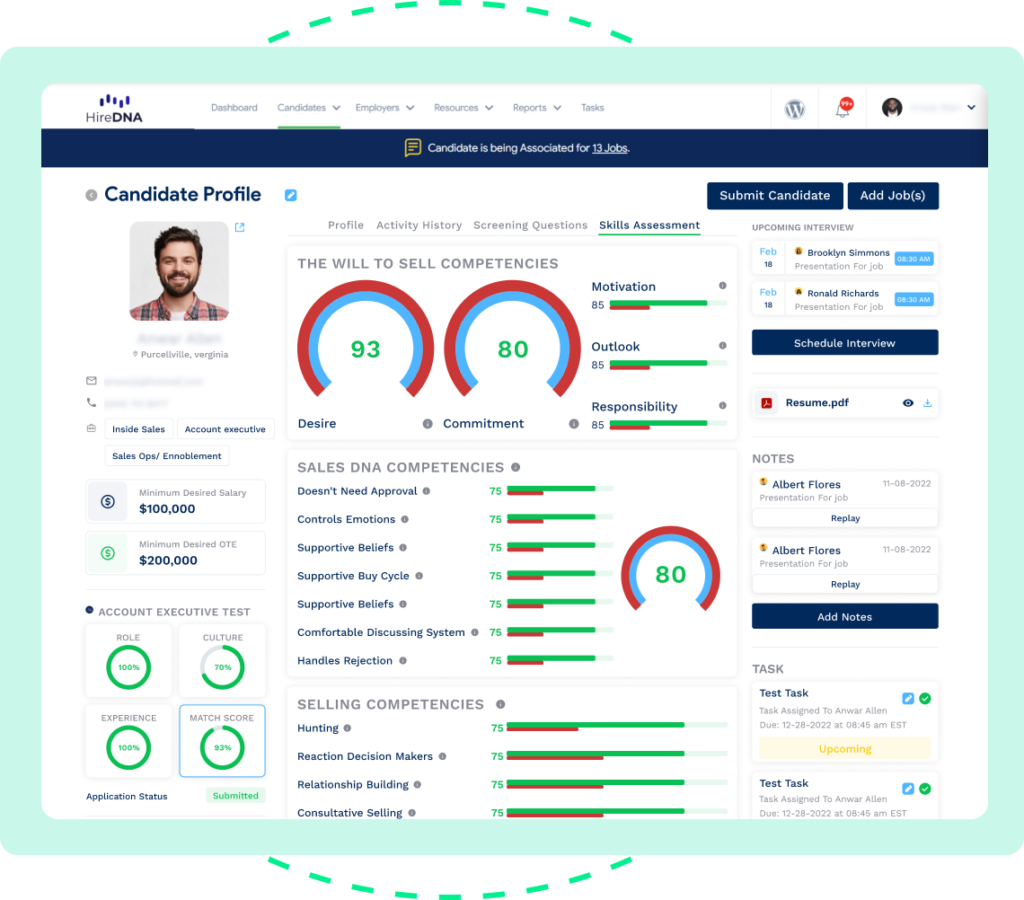Use These Metrics to Ensure Continuous Improvement in Sales Candidate Sourcing and Screening
Published on Jun 13, 2024

Like in most areas of business, I’m a firm believer in incremental progress with sales candidate sourcing and screening. I find that, in most cases, major progress doesn’t happen overnight, but gradually over time.
It’s all about creating an initial process, continuously analyzing that process by looking at the right KPIs, and using your findings to make data-driven decisions to spark tangible improvements. Following that logic, let’s look at some essential metrics that can help you drastically improve the initial stages of sales recruiting.
Volume of Candidates Per Source
Starting from the top, it’s important to know how productive each sales recruiting source is. While this won’t necessarily indicate the quality of each source (we’ll get to that in a second), it should give you a baseline of which sources are producing the most sales candidates.
Here’s an example of what that could look like:
- 30% – Job boards
- 20% – LinkedIn
- 20% – Other social networks
- 10% – Your website careers page
- 10% – Referrals
- 10% – Other sources
Having a basic breakdown like this is helpful for understanding which of your sales recruiting efforts are bringing candidates to you. So if you’re putting a ton of time and money into a particular channel and it’s getting minimal results, it would either need tweaking or you may want to scrap it altogether and focus on other channels that are carrying their weight.
Screening Assessment Completion and Pass Rate
From the screening side of things, there are two main metrics that should shed insight into how effective your current system is and if anything needs changing.
First, there’s the assessment completion rate, which is the percentage of sales candidates that successfully complete any assessments or tests that are part of your screening process. What you’re trying to avoid here is a low completion rate, as this may indicate that your current screening process is too long or complex.
If, for instance, you find that only a small fraction of candidates are making it through the assessment, you may want to trim back the number of questions or exercises and simplify it. The end goal is to find the sweet spot, where you can accurately assess candidates without creating a negative experience.
Also, it’s helpful to look at the pass rate. If your current pass rate is extremely high, this may mean your screening assessment is too easy, which may reduce overall salesperson quality. On the other hand, if the pass rate is overly low, it may mean your screening assessment is too difficult.
Getting it just right will likely require some trial and error, but with some ongoing adjustments, you should be able to optimize it.
Number of Qualified Candidates Per Source
I think we can all agree that effective sales candidate sourcing isn’t just about getting a large volume of candidates. You need to ensure you’re getting qualified candidates.
At HireDNA, for example, we vet sales candidates by examining a wide variety of selling competencies, such as motivation, responsibility, relationship-building, and the ability to handle rejection.

To get your sales candidate sourcing to a high level and ensure it’s continually improving, it’s important to measure how many qualified candidates you get from each source. By “qualified,” I mean candidates with the essential skills and experience for the sales positions you’re hiring for.
Say, for instance, job boards are bringing in the majority of sales candidates. However, only a small percentage of those candidates are truly qualified. You would likely want to improve your job postings to filter out unqualified candidates more effectively. Or, you may want to put less effort on job boards and double down on a different sales recruiting channel that’s bringing in a larger percentage of qualified candidates.
These are just hypotheticals, but you get the idea. The end goal is to find sales recruiting channels that bring in a sizable number of candidates while ensuring the majority of those candidates are qualified. If you can do that successfully, you’ve already won half the battle.
Interview Acceptance Rate
Now let’s talk about the next step in the process — measuring the number of candidates who agree to an interview for a sales position.

This is pretty straightforward, where you simply divide the number of candidates who agree to an interview by the total number of candidates during a given period.
So if four out of 10 candidates agreed to an interview, there would be a 40% acceptance rate.
From my experience, 20 to 30% is about the norm for the application-to-interview rate. This, of course, can vary depending on the exact sales position you’re hiring for. An entry-level sales rep position, for example, would likely have a higher acceptance rate than an account manager.
But if your rate is at 20% or higher, you should be in fairly good shape. That said, going higher to 30%, 40%, or more is even better.
Source to Hire Rate
Going one step further, it’s extremely helpful to know what percentage of successful hires come from each recruiting channel. That way, you not only know which sources are leading to the most interviews but which are leading to the most job offers.
Identifying this should help you figure out which channels are getting the best results, which should translate into more offer-worthy candidates later on. Again, there may be one channel that is driving the lion’s share of candidates, but only a small percentage are converting into actual job offers.
If that’s the case, you would likely want to reassess that channel and either figure out ways to make it more productive or shift your focus to other channels that are getting better results.
Keeping Your Sales Candidate Sourcing and Screening Going Strong
You never want to take your foot off the gas with sales recruiting, and optimizing it should never been seen as a one-off type of deal. Focusing heavily on the initial part of sales hiring in the sourcing and screening phases is particularly important, as it helps set up the subsequent phases.
A big part of improving involves leveraging the right metrics like the ones mentioned above, which should give you an objective overview of what’s working and what’s not so you know exactly what to focus on.
If you’re looking to filter through your sales candidate pool to find the best of the best, I suggest using The Objective Management Group Sales Assessment. It accurately predicts which candidates will thrive in your unique sales environment, with 92% of recommended candidates going on to reach the top half of their sales force. Learn more here.
Image Source: (https://www.pexels.com/)